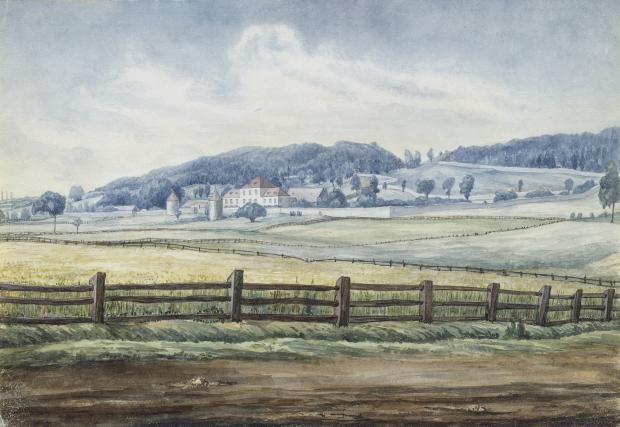The man on the other end of the line seemed embarrassed:
"No, ma’am, I’m sorry, but we cut down our two Fameuse apple trees last year. We were starting to run out of space, and we had to expand for our McIntosh trees. Since the demand wasn’t very high for those apples… And the trees were getting old! Again, my apologies!"
I hung up, stunned. I had just lost one of my last chances to taste the Fameuse, and, more importantly, to obtain a scion of this variety that once grew abundantly in Montreal. Like the vegetables in our gardens, over the past century, countless varieties have disappeared, never to be part of our daily lives again.
Fruit Cultivation in Quebec
Fruit growing in the province has a long history. The first fruit trees to arrive on the continent—such as peach, plum, cherry, and apple trees—were brought over by boat for the benefit of the elite of that era, namely the clergy and the bourgeoisie. Most of the population could not afford the high costs of importing fruit trees from Europe.
There were indeed fruits in the province that the "savages" harvested, but the fruits of the Old Continent were perceived as "more civilized" than those that grew freely in nature without special care. (Source: Réseau des Archives du Québec)
The first settlers, who had few possessions and little wealth, turned to the same wild fruits that Indigenous Peoples had been consuming for generations—abundant berries growing along the edges of forests, such as blackberries, highbush cranberries (Viburnum trilobum), and serviceberries. The seasonal harvest was so plentiful that some surviving writings describe the abundance of these fruits.
In the Montreal region, (…) one only had to reach out a hand to fill it with these delicious fruits.
The Role of Religious Communities
The first orchards in Montreal were established within missionary communities. These religious groups, intent on evangelizing the "savages," sought to settle them permanently by teaching them agriculture and fruit cultivation. Beyond providing income through surplus sales, fruit harvesting ensured the community’s self-sufficiency while also serving a divine purpose: teaching a way of life that required staying in one place year-round, abandoning Indigenous nomadic traditions.
One of Montreal’s largest estates was owned by the Sulpicians—Le Domaine de la Montagne (now part of Westmount at the foot of Mount Royal). This estate included fruit trees, vineyards, and a vegetable garden, all enclosed by a wooden palisade. The abundance of fruit in these orchards was matched only by the discipline and order the religious leaders maintained in their gardens.
.
What Varieties Once Grew in Montreal?
Several fruit varieties thrived in Montreal, where the climate was slightly more favorable for fruit growing. The Bon-Chrétien pear, now nearly extinct, was present as early as the 17th century. The Beauté Flamande pear, introduced around the same time, became more widely popular and is still available from some nurseries today. Damson plums found their way into local culture and remain a recognized variety.
But what happened to the Fameuse apple? One of the first settlers, Louis Hébert, planted it in 1617, and the Sulpicians later cultivated it. This apple became so popular that barrels of it were once exported to England.
What became of the varieties that once flourished on the island?
For those unfamiliar with fruit trees, most are self-sterile, meaning they must be pollinated by another variety to bear fruit. The seeds inside each apple are a genetic mix of two different varieties. If planted, the resulting tree will not be identical to the parent tree but will instead have mixed characteristics, sometimes yielding disappointing results. Additionally, it takes years before the fruit can be tasted, limiting how many trials a person can attempt in a lifetime. That’s why grafting is so valuable: it allows for cloning the original tree, preserving its traits, and accelerating fruit production—since a grafted branch is already mature enough to produce fruit within 4 to 5 years.
Today's fruit varieties are bred to meet modern demands. Many hybrids are developed for climate resistance, disease tolerance, or compact size for small urban spaces. However, these trees often depend on agro-industrial care—constant watering, synthetic fertilizers—to produce round, colorful, and visually appealing fruit. A modern apple orchard left untended will quickly succumb to disease, producing scabby, misshapen fruit.
« But who doesn’t remember an old fruit tree, standing alone in a clearing, untended yet still yielding juicy apples with an intoxicating aroma—apples that children gleefully bite into?
Competition and the Abandonment of Agriculture
As urbanization and industrialization accelerated from the 1830s onward, farmland became scarce. The bourgeoisie was pushed to the western edges of the island and to Île-Bizard. With the arrival of railroads, small orchards could no longer compete with fruit shipped in from Ontario, where the climate was more favorable.
Fruit trees have not entirely vanished from the metropolis, but of the once-grand estates, only street names remain to remind us of a time when Montreal had thriving orchards, long before highways took over.
Perhaps one day, someone will rediscover a forgotten variety in a backyard. And perhaps someone will have the idea to preserve and propagate it so that future generations—our children and grandchildren—can once again enjoy its fruit.
If you have any information about the Fameuse apple or other forgotten varieties, please reach out: info@terrepromise.ca
To learn more...
Patrimoine religieux http://www.patrimoine-religieux.qc.ca/fr/pdf/balado/Balado-RHSJ.pdf
Agriculture urbaine, (2014). Montréal, une ville fruitière? www.agriculturemontreal.com
MARTIN, P.-L. (2002). Les fruits du Québec. Histoire et traditions des douceurs de la table, éditions Septentrion.
RICHARD, M. Blogue « Le Potager d’Antan ».